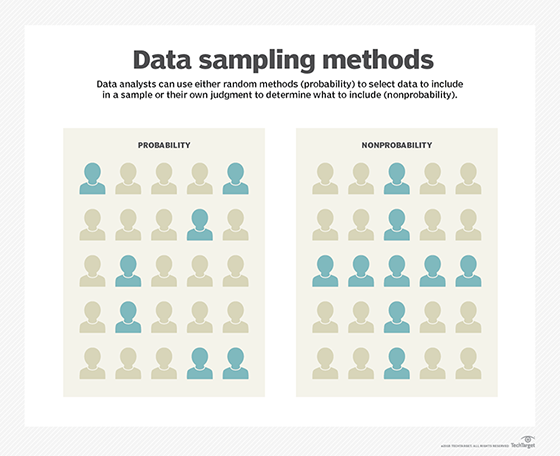data sampling
What is data sampling?
Data sampling is a statistical analysis technique used to select, manipulate and analyze a representative subset of data points to identify patterns and trends in the larger data set being examined. It enables data scientists, predictive modelers and other data analysts to work with a small, manageable amount of data about a statistical population to build and run analytical models more quickly, while still producing accurate findings.
Why is data sampling important?
Data sampling is a widely used statistical approach that can be applied in various use cases, including opinion, web analytics or political polls. For example, a researcher doesn't need to speak with every American to discover the most common method of commuting to work in the U.S. Instead, they can choose 1,000 participants as a representative sample in the hopes that this number will be sufficient to produce accurate results.
Therefore, data sampling enables data scientists and researchers to extrapolate knowledge about a broad population from a smaller sample of data. By taking a data sample, predictions about the larger population can be made with a certain level of confidence without having to collect and analyze data from each member of the population.
Advantages and challenges of data sampling
Data sampling is an effective approach for data analysis that comes with various benefits and also a few challenges.
Benefits of data sampling
- Time savings. Sampling can be particularly useful with data sets that are too large to efficiently analyze in full -- for example, in big data analytics applications or surveys. Identifying and analyzing a representative sample is more efficient and less time-consuming than surveying the entirety of the data or population.
- Cost savings. Data sampling is often more cost-effective than collecting data from the entire population.
- Accuracy. Correct sampling techniques can produce reliable findings. Researchers can accurately interpret information about the total population by selecting a representative sample.
- Flexibility. Data sampling provides researchers with the flexibility to choose from a variety of sampling methods and sample sizes to best address their research questions and make use of their resources.
- Bias elimination. Sampling can help to eliminate bias in data analysis, as a well-designed sample can limit the influence of outliers, errors and other kinds of bias that may impair the analysis of the entire population.
An important consideration, though, is the size of the required data sample and the possibility of introducing a sampling error. In some cases, a small sample can reveal the most important information about a data set. In others, using a larger sample can increase the likelihood of accurately representing the data as a whole, even though the increased size of the sample may impede ease of manipulation and interpretation.
Challenges of data sampling
- Risk of bias. One of the main challenges with data sampling is the possibility of introducing bias into the sample. If the sample is not representative of the population, it can lead to incorrect or misleading conclusions.
- Determining the sample size. With data sampling, determining an appropriate sample size can be difficult sometimes. If the sample size is too small, the results might not be accurate since the sample will not be representative of the population.
- Sampling error. Data sampling can also pose the risk of sampling error, which is the discrepancy between the sample and the population. The accuracy of the results may be affected by this inaccuracy, which may happen by chance, bias or other factors.
- Sampling method. The choice of sampling method can vary depending on the research question and population being studied. However, selecting the appropriate sampling technique can be difficult, as different techniques are better suited for different research questions and populations.
Types of data sampling methods
There are many different methods for drawing samples from data; the ideal one depends on the data set and situation.
The following are the two common types of sampling methods:
Probability sampling
Sampling can be based on probability, an approach that uses random numbers that correspond to points in the data set to ensure that there is no correlation between points chosen for the sample. Further variations in probability sampling include the following:
- Simple random sampling. Software is used to randomly select subjects from the whole population.
- Stratified sampling. Subsets of the data sets or population are created based on a common factor and samples are randomly collected from each subgroup.
- Cluster sampling. The larger data set is divided into subsets (clusters) based on a defined factor, then a random sampling of clusters is analyzed.
- Multistage sampling. A more complicated form of cluster sampling, this method also involves dividing the larger population into a number of clusters. Second-stage clusters are then broken out based on a secondary factor, and those clusters are sampled and analyzed. This staging could continue as multiple subsets are identified, clustered and analyzed.
- Systematic sampling. A sample is created by setting an interval at which to extract data from the larger population -- for example, selecting every 10th row in a spreadsheet of 200 items to create a sample size of 20 rows to analyze.

Non-probability sampling
Sampling can also be based on non-probability, an approach in which a data sample is determined and extracted based on the judgment of the analyst. As inclusion is determined by the analyst, it can be more difficult to extrapolate whether the sample accurately represents the larger population than when probability sampling is used.
Non-probability data sampling methods include the following:
- Convenience sampling. Data is collected from an easily accessible and available group.
- Consecutive sampling. Data is collected from every subject that meets the criteria until the predetermined sample size is met.
- Purposive or judgmental sampling. The researcher selects the data to sample based on predefined criteria.
- Quota sampling. The researcher ensures equal representation within the sample for all subgroups in the data set or population.
Once generated, a sample can be used for predictive analytics. For example, a retail business might use data sampling to uncover patterns in customer behavior and predictive modeling to create more effective sales strategies.
Common data sampling errors
A sampling error is a difference between the sampled value and the true population value. Sampling errors happen during data collection when the sample is not typical of the population or is biased in some way.
Because a sample is merely an approximation of the population from which it is collected, even randomized samples will have some sampling error.
The following are some common data sampling errors:
- Sampling error. Sampling bias arises when the sample is not representative of the population. This can occur when the sampling method is incorrect or when there is a systemic inaccuracy in the sampling process. Errors may develop as a result of a large variance in a specific metric across a specified date range. Alternatively, they could happen due to a generally low volume of a given measure in relation to visits. For instance, if a site has a very low transaction count in comparison to overall visits, sampling may result in substantial disparities.
- Selection error. Selection bias arises when the sample is chosen in a way that favors a specific group or trait. For example, if a health study is only conducted on people who are willing to participate, the sample may not be representative of the overall community.
- Non-response error. This bias happens when people chosen for the sample do not participate in the survey or study. As a result, certain groups may be underrepresented, affecting the accuracy of the results.
Data sampling process
The process of data sampling typically involves the following steps:
- Defining the population. The population is the entire set of data from which the sample is drawn. To guarantee that the sample is representative of the entire population, the target population must be precisely defined, including all essential traits and criteria.
- Selecting a sampling technique. The next step is to choose the best sampling method based on the research question and the characteristics of the population under study. There are several methods for drawing samples from data such as simple random sampling, cluster sampling, stratified sampling and systematic sampling.
- Determining the sample size. The optimum sample size required to produce accurate and reliable results should be decided in this phase. This decision may be influenced by certain factors, such as money, time constraints and the requirement for greater precision. The sample size should be large enough to be representative of the population, but not so large that it becomes impractical to work with.
- Collecting the data. The data is collected from the sample using the sampling approach that was chosen, such as interviews, surveys or observations. This may entail random selection or other stated criteria, depending on the research question. For example, in random sampling, data points are selected at random from the population.
- Analyzing the sample data. After collecting the data sample, it's processed and analyzed to draw conclusions about the population. The results of the analysis are then generalized or applied to the entire population.
Predictive analytics is being used by many organizations to forecast occurrences and improve the accuracy of data-driven choices. Examine the four popular simulation approaches used in data analytics.







